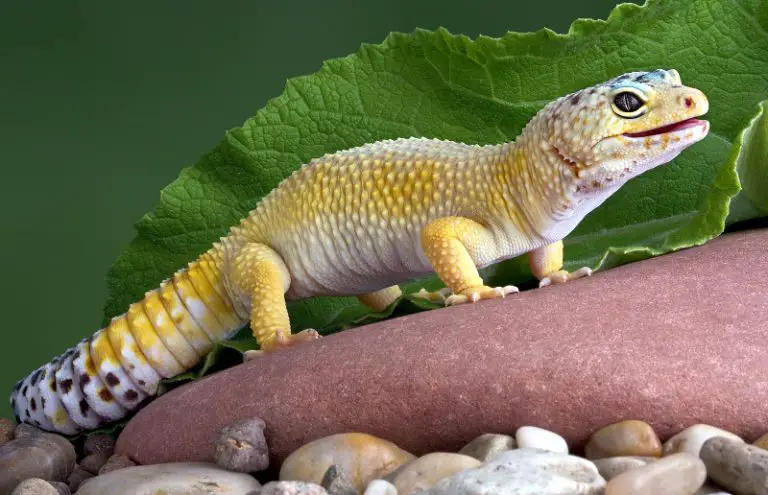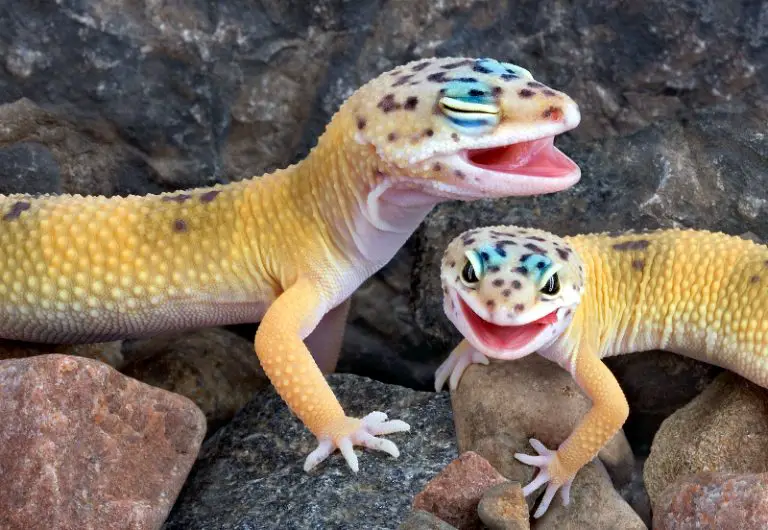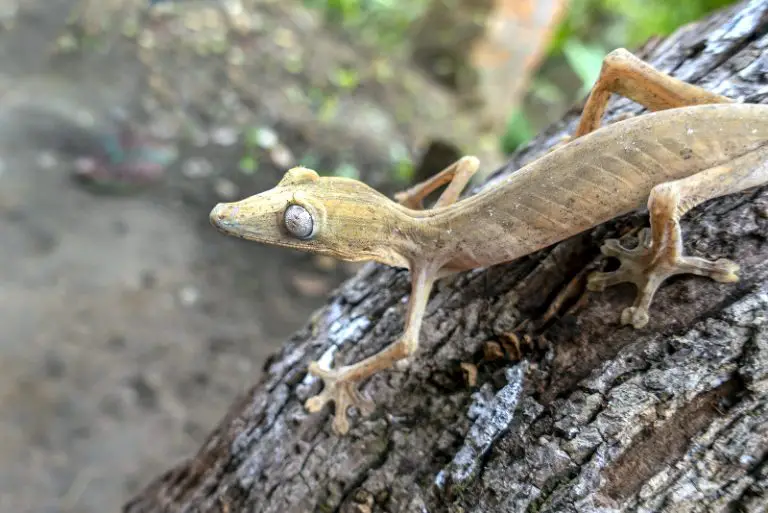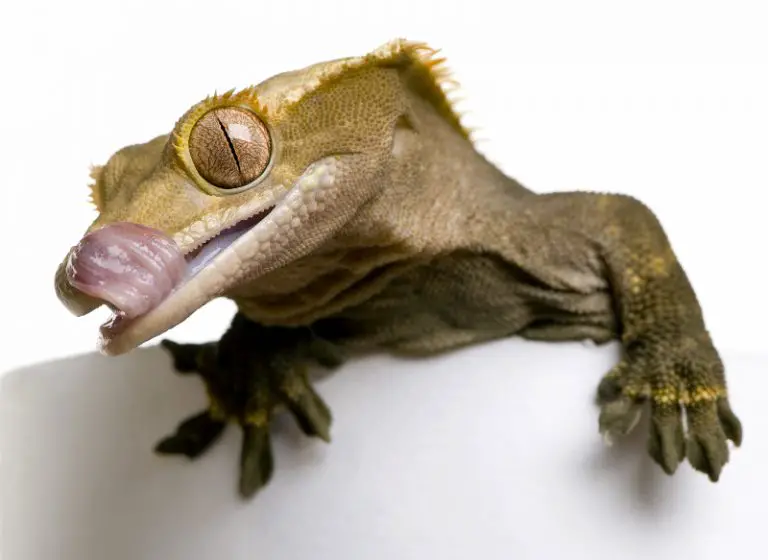What Fruit Can Crested Geckos Eat? [Best Fruit]

If you’ve been thinking about adopting a crested gecko, you’ve probably been wondering what to feed it. What Fruit Can Crested Geckos Eat? Are fruits okay? Are veggies? You’ve probably heard a few different things. Most crested gecko owners feed their lizards a diet of commercially-made foods. These foods are rich in vitamins and nutrients, and the lizards don’t need anything else.

Others choose to feed their geckos foods that more resemble their diets in the wild. This includes fruits and veggies. But are fruits actually okay to feed crested geckos? The short answer is yes — fruit is safe and healthy to feed your crested gecko — just be careful which ones you pick.
Some fruits are very healthy and beneficial to your geckos. Others are okay, but should only be given occasionally as snacks. Others can be extremely detrimental to your lizard’s health and should never be fed. Keep reading to find out which fruits you can feed your crested gecko and which ones you should avoid.
Contents
Table of Contents
What Is A Crested Gecko?
Crested geckos are a much loved species of lizard among reptile enthusiasts. They are perfect for beginners because they are so easy to care for with their docile nature. Even experienced reptile keepers love them because they’re very active and entertaining to watch.
Their History
Interestingly, crested geckos were thought to be extinct not that long ago. They hadn’t been seen in years until scientists “rediscovered” them in 1994. They were found on the island of New Caledonia in the South Pacific.
Their Appearance
Besides their docile and active personalities, crested geckos are popular for their physical appearance. Although they are a dull brown color, they look like a little dragon with eyelashes.
Crested geckos have two lines of spiky ridges that begin at the top of their eyeballs that resemble large eyelashes. Those ridges then continue down the lizard’s back.
They also have special toe pads that allow them to easily stick to surfaces like their glass aquariums.
Although they don’t really like to be handled, they are fun to watch. They are very active creatures that like to crawl among the leaves of hanging plants, and they are great jumpers.
Pros And Cons Of Feeding Fruit To A Crested Gecko
Crested geckos don’t technically need fruits to have a healthy, well-rounded diet. Many crested geckos live solely off commercially-prepared powdered foods.
Most of these commercially-made foods have become so advanced that they provide crested geckos with a full, well-rounded diet. Most people don’t bother feeding their geckos anything other than these commercially-made foods because it’s not necessary.
So, does feeding your crested gecko fresh fruits have any advantages?
Their Diet In The Wild
In the wild, crested geckos don’t live off the same foods everyday. Although it’s possible for them to live solely off pre-made foods, having a variety of foods provides them with more nutrients. In the wild, and in captivity, crested geckos feed on a variety of fruits, vegetables, and insects. Today, we’ll be focusing on fruits.
Various studies over the years have found that a wild crested gecko’s diet consists of about 11.7% berries and 7.52% fruits. This is almost 20% of the gecko’s total diet. If fruits play such a huge role in a wild gecko’s diet, wouldn’t it make sense that they should eat fruits in captivity too?
Watch this video: 10+ Fruits Crested Geckos can Eat
All About The Calcium To Phosphorus Ratio
Crested geckos need lots of calcium in their diet to stay healthy. Commercially-made foods will usually have enough calcium built in to be sufficient, but fruits can be a good supplement.
The Importance Of Calcium
If you plan to feed your crested gecko fruit, just keep in mind that some fruits are better than others. You should choose fruits that are moderate or high in calcium, but are also low in phosphorous.
Calcium is very important in the bone development of your crested gecko. Receiving enough calcium prevents the reptiles from developing metabolic bone disease. Although calcium is important at all ages, it’s especially important for still-growing juveniles.
Gravid females are also extra dependent on calcium supplies. They need the extra source of calcium for the development of their eggs.
Balancing Calcium And Phosphorus
Calcium and phosphorous are two opposite elements. Although phosphorous is also important in the development of the bones, too much can be dangerous. Calcium is far more important in bone development for lizards.
When there is too much phosphorous in the body, calcium is pulled from the bones and can lead to problems. The more calcium the lizard eats, the more the phosphorous levels are lowered. The more phosphorous is eaten, the less calcium there will be.
For crested geckos, it’s important for them to have a calcium to phosphorous ratio of 2:1 or better. This means that they need a lot more calcium in their bodies then phosphorous.
This also means that, if you plan on feeding your lizard fruits, you should plan to feed them fruits rich in calcium and low in phosphorous.
How exactly will you know whether you’re giving your lizard the correct amounts of phosphorous and calcium? Fortunately, it’s not as hard as you think.
How To Calculate The Calcium : Phosphorous Ratio
Most often, this ratio is calculated similar to a fraction like this: x:x. Calcium will always come first (you always want this number to be larger), and phosphorous will come last (you always want this number to be smaller). You always want phosphorous to be lower than calcium.
The best way to determine if your lizard is getting the right amount is by getting the calcium to phosphorous ratio down to 2:1. This is simply done by dividing the amount of each nutrient in the food.
To calculate this, you’re going to need to know the nutritive values of the fruits you’re giving.
For example, if a fruit contains 100mg of calcium, and 50mg of phosphorous, then you will divide 100mg by 50mg (the amount of calcium by phosphorous). Then you will divide 50mg by 50mg (the amount of phosphorous by itself). This will get us down to a calcium to phosphorous ratio of 2:1, and you’ll know that the fruit is safe for your lizard to eat.
To make this example clearer, we’ve written it into a table:
| Element | Amount | Ratio |
| Calcium | 100mg | 100/50=2 |
| Phosphorus | 50mg | 50/50=1 |
| Ca:P Ratio | 2:1 |
For crested geckos, you ALWAYS want the amount of calcium to be higher than phosphorous. If you perform this equation, and there is more phosphorous than calcium, then that fruit is not safe for your reptile to eat.
What Fruit Can Crested Geckos Eat?
Unfortunately, most fruits are high in phosphorous and low in calcium. This creates a problem when you are trying to find fruits that are safe to give to your crested gecko.
So, what fruits do crested geckos eat? What’s safe? What fruit can I feed my crested gecko?
Below, we have provided a list of fruits that are HIGH in calcium, and low in phosphorous. These are fruits crested geckos can eat:
- Figs
- Oranges
- Papayas
- Prickly Pears
- Raspberries
Below, we have created a list of fruits that are MODERATE in calcium. The calcium and phosphorous ratio are about the same. These fruits can still be fed fairly often, but should not be given as often as fruits high in calcium:
- Apples
- Blackberries
- Blueberries
- Cherries
- Melons
- Pears
- Strawberries
- Watermelon
Below, we have provided a list of fruits that are LOW in calcium and HIGH in phosphorous. You don’t necessarily need to avoid these fruits, but they shouldn’t be given very often. Instead, if you choose to feed them, they should only be given as an occasional snack:
- Bananas
- Cantaloupes
- Passion Fruit
- Peaches
- Plums
- Pomegranates
- Pumpkins
- Starfruit
What Are The Best Fruit For Crested Gecko?
As we stated above, the best fruits to provide to your crested gecko are figs, oranges, papayas, prickly pears, and raspberries. These fruits are all high in calcium and low in phosphorous. They will all make wonderful additions to your lizard’s daily diet.
Can Crested Geckos Eat Strawberries?
Strawberries have a 1:1 calcium to phosphorous ratio. They are safe to feed to your crested geckos, although they shouldn’t be given as often as the fruits that have a higher calcium to phosphorous ratio.
Can Crested Geckos Eat Grapes?
Grapes have a calcium to phosphorous ratio of 1.4:1. However, they do have low levels of oxalic acid. We’ll explain why oxalic acids are bad later. Although you don’t need to avoid them completely, they really should only be given as occasional treats.
Can Crested Geckos Eat Apples?
Apples also have a moderate calcium to phosphorous ratio, so they are generally okay to feed to your crested gecko.
Can Crested Geckos Eat Pineapple?
Pineapples are a citrus fruit and are high in oxalic acids. These should be avoided and never given to your crested gecko.
Can Crested Geckos Eat Mango?
Mangoes have a calcium to phosphorous ratio of 1:1 and contain a medium amount of oxalic acid. Although they are not bad to give to your geckos, they should only be given sparingly.
Can Crested Geckos Eat Watermelon?
Watermelons contain a moderate calcium to phosphorous ratio and are safe for crested gecko consumption.
What Fruit Should Crested Geckos Not Eat?
You should NEVER give your crested gecko citrus fruits because they can harm your gecko’s health. Citrus fruits are high in Vitamin C. While this vitamin is important in the diet of humans, it can cause diarrhea in crested geckos. They are also high in oxalic acids. We’ll go over why those are bad next.
Avoid Oxalic Acids
Oxalic acid is a naturally occurring compound in fruits and vegetables, but it’s detrimental to the health of your crested gecko. Oxalic acid binds to calcium, preventing the absorption of calcium into the body. As you know, calcium is a vitally important nutrient for crested geckos, so oxalic acids should be avoided at all costs.
You should avoid feeding your gecko fruits and vegetables high in oxalic acids. Dangerous foods include rhubarbs, star fruit, and spinach.
Avocado
Avocados contain a chemical called persin. This is a very dangerous chemical in many pets that can lead to death. Although the effects on reptiles is not well studied, it is assumed that it would have similar effects as it has on other small animals.
How Often Can I Feed Fruit To My Crested Gecko?
How often you should feed fruit to your crested gecko really depends on what kind of a diet you feed them.
Geckos that are fed entirely commercially-made foods should only receive fruits as a snack a few times a month. Fruits are rich in calcium and vitamins, but the store-bought food is already going to have these nutrients. You don’t want to overdose them on nutrients, so the fruits are better left as snacks.
Some people don’t like to use commercially-made foods, though. Some simply like to feed diets that are closer to the reptile’s diet in the wild. This consists of a mixture of insects, fruits, veggies, and supplements. If this is how you choose to feed your gecko, then they should receive fruits every 2-3 days.
Just keep in mind that you need to be careful if you feed a more “wild-like” diet versus a commercially-made diet. It’s much harder to provide a nutrient-rich, balanced diet when you’re not using commercially-made food. If you’re a new gecko owner, experts recommend sticking to pre-made foods and using fruits as snacks only.
If you’d like to try giving your crested gecko a balanced diet of insects, fruits, and veggies, be sure to pick foods high in calcium and low in phosphorous. Those foods can safely be a regular part of your geckos diet. Avoid fruits high in phosphorous and only give them occasionally as snacks.
Read our full guide to how often crested geckos should eat here.
How To Prepare Fruit For Your Crested Gecko
Crested geckos have pretty small mouths, so it’s pretty obvious that you shouldn’t feed them full pieces of fruit. You should either mince them into small, bite-sized pieces, or mash them up.
Supplements
It’s also important to provide your geckos with calcium and vitamin D3 supplements. These supplements usually come in powders that you can mix into their regular food. Some people sprinkle these powders over live insects, but you can mix them into fruit as well.
Cleaning
When you go to eat your favorite fruit, you always clean it first. Most people wouldn’t dream of eating an unwashed fruit because it can contain dirt, bacteria, and pesticides. For the same reason, you should always wash fruit before giving it to your crested gecko.
In fact, your lizard is more likely to be sensitive to these impurities than we are, so you want to avoid causing any problems.
Thoroughly wash any fruit you want to give your gecko, making sure to scrub the peel with fresh water. You’ll also want to remove any toxins contained in the fruit such as the core and seeds of the apple.
The seeds contain cyanide and can kill you if you eat enough. Crested geckos are small, so it won’t take a large amount of seeds to hurt them.
Conclusion
Although fruits can be a great addition to your crested gecko’s diet, you should take care when choosing which fruits you provide. Some fruits, like figs, oranges, and raspberries are great sources of calcium. Others, like citrus fruits, are dangerous and should never be given.
When it comes down to it, fruits are great for your gecko in moderation. Some people feed their geckos a diet that closer resembles their diet in the wild. These geckos are going to need a larger variety of fruits. Geckos on a commercial-food diet don’t really need fruits, but they are a good snack.
If you’ve ever wondered if you should feed your crested gecko fruits, now you know exactly how to do it safely. By providing yummy, healthy fruits, your gecko will receive more variety and will be happier.
You can find more guides to caring for your gecko here or click here to read how often crested geckos should eat.






![Can Geckos Swim? [Must Read]](https://allourcreatures.com/wp-content/uploads/2021/12/gecko-cool-768x513.jpg)